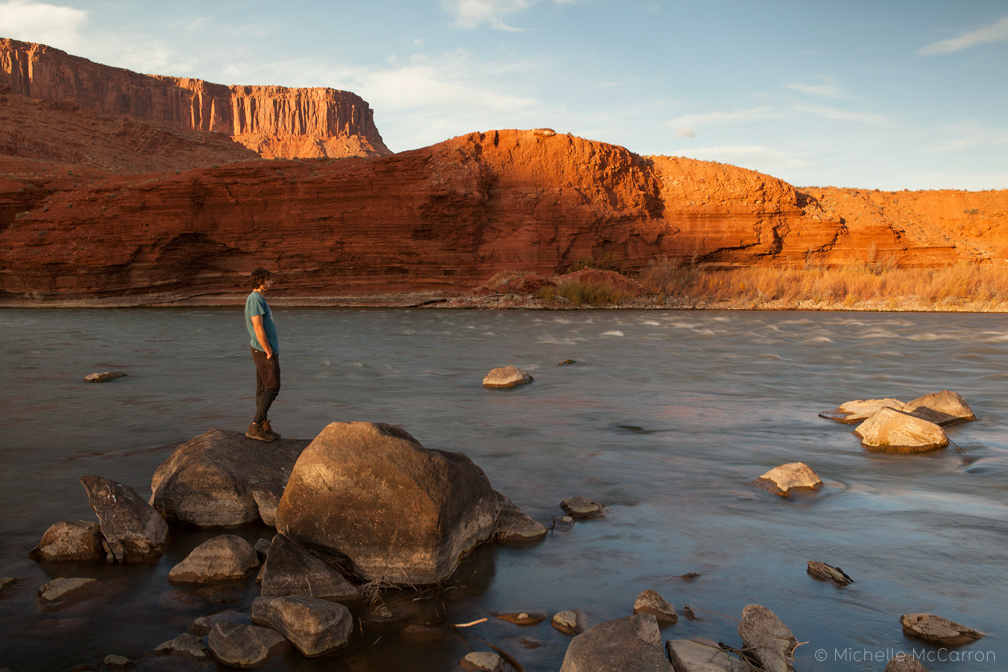
by Deep Green Resistance News Service | Nov 5, 2017 | Listening to the Land
Featured image by Michelle McCarron
Editor’s note: This is the latest installment from Will Falk as he follows the Colorado River from headwaters to delta, before heading to court to argue for the Colorado River to be recognized as having inherent rights. More details on the lawsuit are here. The index of dispatches is here.
by Will Falk / Deep Green Resistance Southwest Coalition
Hear the white crash of her torrents on the boulders she drags through the desert, feel the unyielding red rock she pushes through, lose your balance in the impatience of her swift streams, and you’ll know: The Colorado River needs to provide her waters and yearns for her home in the sea.
I spent several hours in silence with the Colorado River last night listening to her speak of her desires while I pondered our lawsuit that seeks rights for the river. I saw the silver sparks of minnows playing under brown stones. I watched the wind shower gray pools with gold cottonwood leaves. I was washed away in the vertigo caused by the river’s speed conflicting with the primordial stillness of canyon walls. I did not hear a judge’s gavel, evidentiary proceedings, or opposing counsel’s objections. In fact, I neither saw nor heard anything human, save my hands cupped to gather water and the soft beat of blood over my eardrums.
I wondered if the arguments tossed around the small confines of a courtroom or the abstract rights possessing little meaning beyond that granted them by the human mind could give the river what she needs. The river’s needs are physical, concrete, and real. She needs dams to be removed, she needs annual snowfall to return to pre-industrial levels, and she needs poisonous chemicals to be filtered out of her. The question becomes: Can our lawsuit give the river what she needs?
Our lawsuit asks a judge to rule that the Colorado River is a person capable of possessing the rights to exist, flourish, regenerate, and naturally evolve. Personhood gives the person possessing a right the ability to ask a court to enforce the right. A court enforces a right by commanding someone to stop an activity infringing upon a person’s right or by commanding someone to pay the person whose rights were infringed upon. A court ensures a command is followed by calling upon the police (men and women with guns) to compel compliance with a court order.
It is important to understand that filing a lawsuit is nothing more than an attempt to persuade a judge to use force, or the threat of force, to compel someone to act in a certain way. Our Colorado River lawsuit is an attempt to persuade a federal judge to order the State of Colorado to stop activities and projects that violate the river’s rights to exist, flourish, regenerate, and naturally evolve.
If our lawsuit succeeded, and the State of Colorado’s destructive activities were stopped, then, yes, the lawsuit would help to give the Colorado River what she needs. But, the closer our first hearing on November 14 gets, the more anxious I become. My anxiety is rooted in the fact that we do not have control over what happens in the case. Not truly. The lawsuit leaves it up to a judge who spends most of her time behind the walls and under the roof of a courthouse, who most likely lacks the time to sit humbly at the river’s banks to ask her what she needs.
This anxiety is nothing new. It is an anxiety that has become all too familiar to the environmental movement. We continue to lose, the natural world continues to be murdered, because the vast majority of our efforts are spent trying to convince someone else to do the right thing. We can continue to ask someone else to protect those we love, or we can protect them ourselves. More than anything else, the Colorado River needs dams to fall and her waters replenished. The good news is: a court order isn’t the only way a dam falls.
To repost this or other DGR original writings, please contact newsservice@deepgreenresistance.org
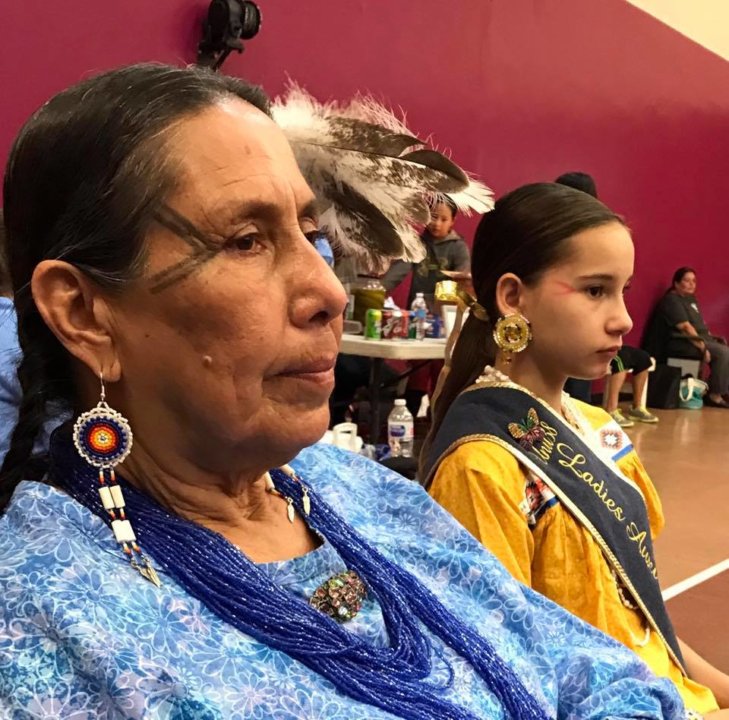
by Deep Green Resistance News Service | Nov 1, 2017 | Indigenous Autonomy
Featured image: Casey Camp-Horinek with her granddaughter
by Movement Rights / via Intercontinental Cry
San Francisco, CA – After suffering for years with poisoned water and serious health issues due to fracking and injection wells on and near their reservation the governing body of the Ponca Nation of Oklahoma voted to pass a statute recognizing the rights of nature on Friday, October 20, 2017. When enacted, the Ponca will be the first tribal nation to recognize the rights of nature into statutory law.
“On Friday, October 20th the Ponca Tribe of Oklahoma took the historic step of agreeing to add a statute to enact the Rights of Nature. We are proud to be moving into the future by honoring our original instructions to respect all life on our Mother Earth,” said Casey Camp-Horinek, a member of the Ponca Tribal Business Council. “We would like to thank everyone who has brought information about the Rights of Nature and those who continue to share ways to bring back respect for the natural laws that have sustained all life for millenniums. A special thanks to Movement Rights founders, Shannon Biggs and Pennie Opal Plant for all the support provided over the last few years.”
Movement Rights has been working with members of the Ponca Nation to assist the tribe with fracking issues utilizing the recognition of the rights of nature as a model to protect the land and health of tribal members. “Dozens of communities in the United States and several countries, including New Zealand, India, Ecuador and Bolivia, have passed laws that stop treating nature as property to be destroyed. The rights of nature legal framework recognizes the legal rights of ecosystems to exist and regenerate their vital life cycles,” said Shannon Biggs, the Executive Director of Movement Rights. “These communities and countries are using this new legal framework to protect people and natural communities from harmful activities including fracking. They are shifting human law to align with natural law.”
Ponca, Oklahoma is the epicenter of earthquakes caused by fracking and injection wells. Tribal members have experienced diseases that have decimated their population since the fracking industry began in their area. Every single water well on the reservation is too toxic to drink, bathe in or allow pets and livestock to drink. There have been 448 earthquakes in and around the Ponca reservation this year, in a state that was essentially earthquake free before the fracking industry moved in to the area. The Ponca Nation is expected to enact the Rights of Nature Statute into law by the end of 2017.
“We all know that water is life. The years of fish kills related to the fracking and injection wells amount to environmental genocide,” said Casey Camp-Horinek. “It is going to take all of us humans because we’re speaking for those without voices, for the deer, the cattle, those that fly. In our tribe we have a funeral a week now. We’re being fracked to death and It’s time to take a stand for our people and defend the earth.”
The Ponca Nation and Movement Rights also conducted two events which took place on Saturday, October 22nd called “Ponca Environmental Community Action Day”. The day included a prayer walk to the Phillips 66 refinery in the City of Ponca as well as a community meeting. “I feel like we are gaining strength, we had more tribal nations represented this time as well as non-natives,” said Ponca Tribal member, Suzaatah Williams. “We had elders and even a newborn on this walk and every age group in between. Even if only one of these people share the information they learned we have made a difference. Knowledge is power and we are only getting stronger!”
Speakers for the community events included Casey Camp-Horinek, Mekasi Horinek, Shannon Biggs, Bryan Parras of the Sierra Club and TEJAS in Houston, Texas, and Robby Diesu, coordinator for the National Stop the Frack Attack Network based in Washington, DC.
“Most importantly, thanks to our Creator, Wakonda,” said Casey Camp-Horinek. “We believe that the prayers and guidance provided are leading us to further protect our Mother Earth, who sustains us; and make a way for the generations to come.”
Contact:
Casey Camp-Horinek caseycamphorinek@yahoo.com (580) 716-7015
Shannon Biggs shannon@movementrights.com (415) 298-9419
Pennie Opal Plant pennie@gatheringtribes.com (510) 390-0386
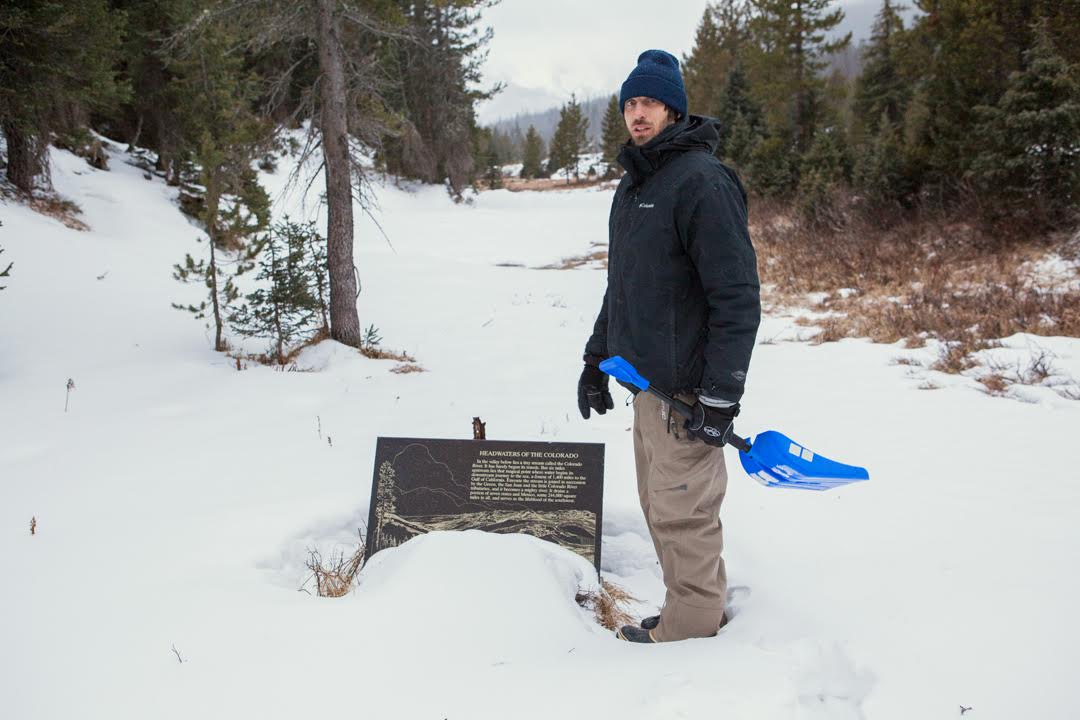
by DGR News Service | Oct 29, 2017 | Listening to the Land
Featured image by Michelle McCarron
Editor’s note: This is the latest installment from Will Falk as he follows the Colorado River from headwaters to delta, before heading to court to argue for the Colorado River to be recognized as having inherent rights. More details on the lawsuit are here. The index of dispatches is here.
by Will Falk / Deep Green Resistance Southwest Coalition
To truly understand someone, you must begin at her birth. So, Michelle and I spent the last two days looking for the Colorado River’s headwaters in the cold and snow above La Poudre Pass on the north edge of Rocky Mountain National Park. The pass is accessible by Long Draw Road off of Colorado Highway 14. Long Draw Road is an unpaved, winding, pot-holed trek that takes you fourteen miles through pine and fir forests and past the frigid Long Draw Reservoir before ending abruptly in a willow’d flat.
We found the road covered in an inch of frosty mud which required slow speeds to avoid sliding into roadside ditches. The drive served as a preparatory period in our journey to the Colorado River’s beginnings. The road’s ruggedness and incessant bumps combined with sub-freezing temperatures to ask us if we were serious about seeing the Colorado River’s headwaters. I was worried that Michelle’s ’91 Toyota Previa might struggle up the pass, but the van continued to live up to the Previa model’s cult status.
Long Draw Road foreshadowed the violence we found at the river’s headwaters. Swathes of clearcut forests escorted the road to the pass. The Forest Service must be too lazy to remove single trees from the road as they fall because Forest Service employees had simply chainsawed every tree within fifty-yards to the left and right of the road. About 3 miles from the road’s end, we ran into a long, low dam trapping mountain run-off into Long Draw Reservoir. We expected to find wilderness in La Poudre Pass, so the dam felt like running into a wall in the dark.
The clearcuts, dam, and reservoir are grievous wounds, but none of them are as bad as the Grand Ditch. We walked a quarter-mile from the end of Long Draw Road where we found a sign marking the location of the river’s headwaters. On our way to the sign, we crossed over a 30-feet deep and 30-feet wide ditch pushing water west to east. We were on the west side of the Continental Divide where water naturally flows west. We contemplated what black magic engineers employed to achieve this feat. The ditch was as conspicuous in La Poudre Pass as a scarred-over gouge on a human face.
The Grand Ditch was begun in the late 1880s and dug by mostly Japanese crews armed with hand tools and black powder. It was built to carry water, diverted from the Colorado River’s headwaters, east to growing cities on Colorado’s Front Range. Close to two feet of swift water ran through the ditch. We learned that even before melting snowpack forms the tiny mountain streams identifiable as the Colorado River’s origins, water is stolen from her. Pausing in a half-foot of powder, I wondered whether the water stored here would end up on a Fort Collins golf course or stirred by the fins of a Vaquita porpoise in the Gulf of California.
Study the Colorado River’s birth and you’ll learn she is born from a wild womb formed by heavy winter clouds, tall mountain peaks, and snowpack. But, she emerges from this womb immediately into exploitation. In La Poudre Pass, the young Colorado River tastes the violence that will follow her the rest of her life.
To repost this or other DGR original writings, please contact newsservice@deepgreenresistance.org
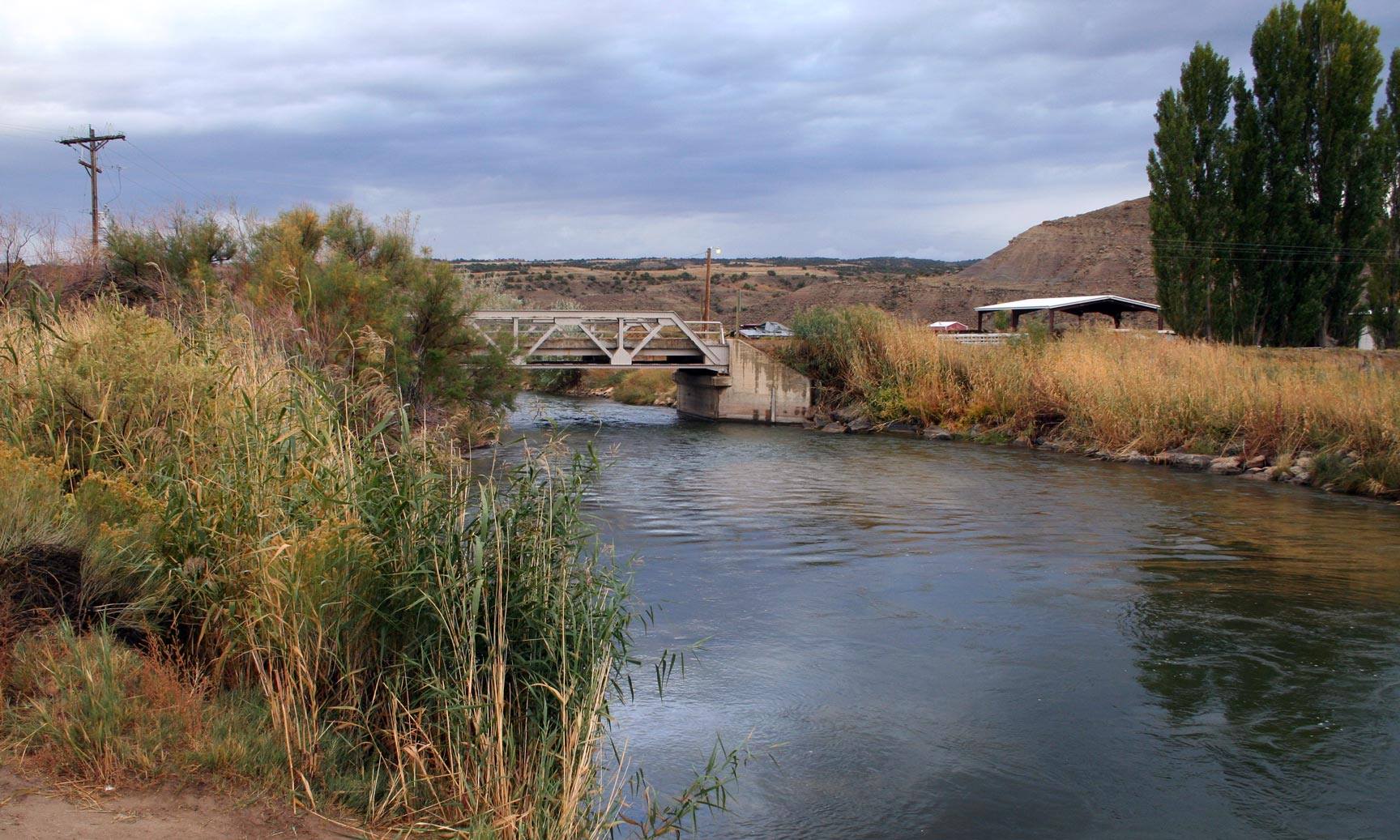
by DGR News Service | Oct 25, 2017 | Listening to the Land
Featured image by Michelle McCarron
Editor’s note: This is the latest installment from Will Falk as he follows the Colorado River from headwaters to delta, before heading to court to argue for the Colorado River to be recognized as having inherent rights. More details on the lawsuit are here. The index of dispatches is here.
by Will Falk / Deep Green Resistance Southwest Coalition
When I agreed to serve as a “next friend” to the Colorado River in a first-ever federal lawsuit seeking personhood and rights of nature for the river, I agreed to represent the river’s interests in court. On a general level, it’s not difficult to conceptualize the Colorado River’s interests: pollution kills the river’s inhabitants, climate change threatens the snowpack that provides much of the river’s water, and dams prevent the river from flowing to the sea in the Gulf of California.
We seek personhood for the Colorado River, however, and this entails personal relationship with her. Water is one of Life’s first vernaculars and the Colorado River speaks an ancient dialect. Snowpack murmurs in the melting sun. Rare desert rain runs off willow branches to ring across lazy pools. Streams running over dappled stones sing treble while distant falls take the bass.
Personal relationship requires that you learn who the other is. Our first day in court is scheduled for Tuesday, November 14, at 10 AM [you’re invited to attend]. So, I will spend the next few weeks leading up to the court date traveling with the river, sleeping on her banks, and listening. I will ask the Colorado River who she is, and then, if she’ll tell me, I’ll ask her what she needs.
When I arrive at the United States District Court in Denver, I hope to bring the Colorado River’s answer.
(I’ll post notes from the road. And, I’m excited to be meeting up with the brilliant photographer Michelle McCarron soon.)
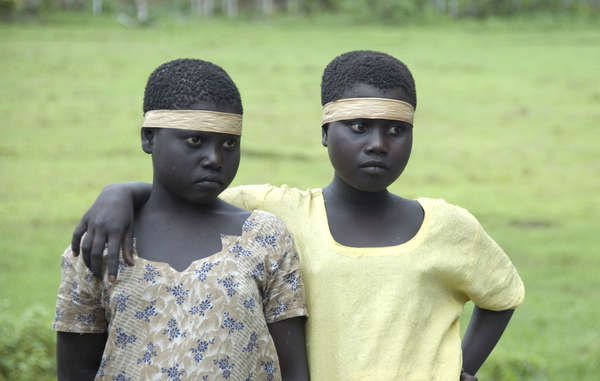
by Deep Green Resistance News Service | Sep 19, 2017 | Indigenous Autonomy
Featured image: Human safaris have risked exposing the Jarawa to diseases to which they have no immunity. © Survival
by Survival International
Notorious “human safaris” in India’s Andaman Islands may soon stop, after the authorities announced that a new sea route around the islands will soon open.
The new route will keep tourists off the infamous Andaman Trunk Road, which was built illegally through the forests of the isolated Jarawa tribe.
The road brings a daily invasion of hundreds of tourists into the heart of the Jarawa reserve, who treat the Jarawa like animals in a safari park.
One tourist described his trip: “The journey through tribal reserve was like a safari ride as we were going amidst dense tropical rainforest and looking for wild animals, Jarawa tribals to be specific.”
The Jarawa, like all recently contacted peoples, face catastrophe unless their land is protected.
The human safaris are also dangerous – one Jarawa boy lost his arm after tourists threw food at him from a moving vehicle.
In 2002 India’s Supreme Court ordered the road closed, but it has remained open.
Survival International led a global campaign against the human safaris, calling for a boycott of the Andaman tourist industry until they came to an end. Nearly 17,000 people from around the world pledged not to holiday in the islands in protest.
The boycott will be called off as soon as the Andaman government agrees to ensure that tourists are no longer able to use the road.
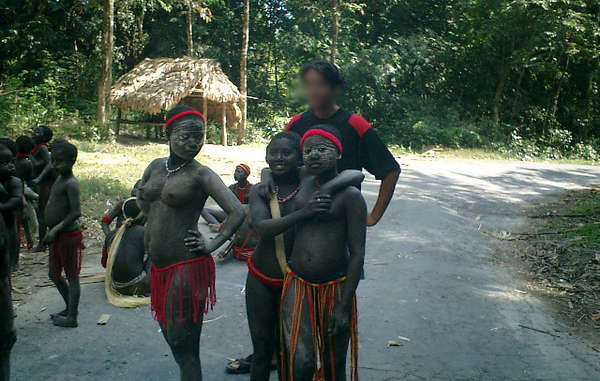
A tourist poses with a group of Jarawa. © Mauricio Cordova / Survival International 2008
Background briefing
– In 2012, shocking footage emerged of Jarawa girls being made to dance at the side of the road, during a human safari. This led to a global outcry against the dehumanizing use of tribal people as tourist exhibits.
– The Jarawa are one of the tribes indigenous to the Andaman islands. They live as hunter gatherers, and chose to reject contact with mainstream Indian society until 1998. Several other Andamanese tribes were wiped out following British colonization of the islands in the 19th century.
– In 1999 and 2006, the Jarawa suffered outbreaks of measles – a disease which has devastated many recently contacted tribes. and which is often a consequence of forced contact.
-Tourism is a major industry in the Andaman islands. The new sea route will be used to access the north of the islands and attractions like the limestone caves and mud volcano at Baratang without tourists intruding into the land of the Jarawa.
– The Islands’ Lieutenant-Governor, Professor Mukhi, announced recently that the sea route will be quicker and more comfortable than the current journey by road.
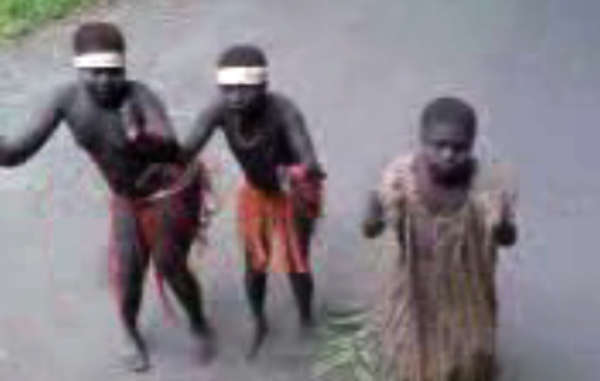
Still from video showing Jarawa girls forced to dance during a human safari. © Anon
Survival’s Director Stephen Corry said: “Treating the Jarawa as a tourist spectacle was a disgusting practice – it also put their lives in danger. It’s more than time for the human safaris to end. If this sea route can do that, then we welcome it. If not, we’ll carry on campaigning until the Jarawa’s right to determine their own futures and stop being harassed by tourists is secure.”
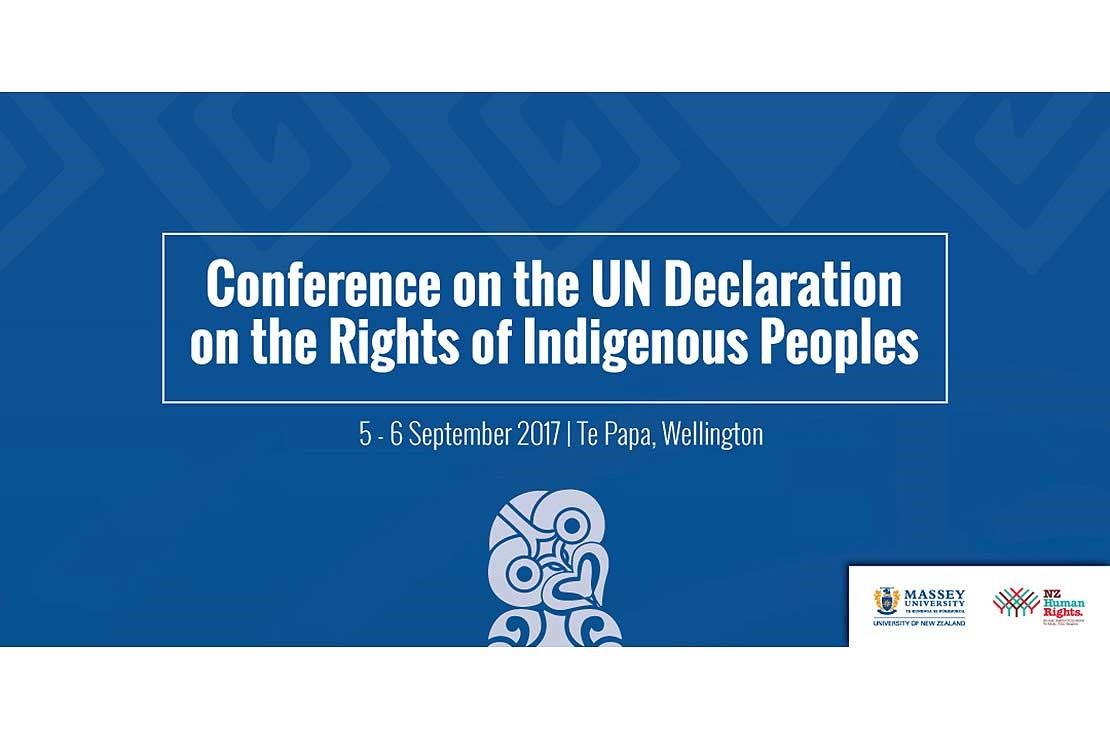
by Deep Green Resistance News Service | Sep 18, 2017 | Indigenous Autonomy
by Rawiri Taonui / Cultural Survival
This month marks the 10th anniversary of the signing of the Declaration on the Rights of Indigenous Peoples (UNDRIP 2007). Indigenous Peoples have come a long way. Our individual struggles coalesced during the 1970s in the Indigenous-initiated World Council of Indigenous Peoples. A decade of consultation and negotiation through the United Nations culminated in a first draft. Some of those who had worked on the draft lost their lives in struggles at home.
Consultation with states followed. On one side, the will of Indigenous representatives to craft a document worthy of the aspirations of first nation communities; on the other side the reservation of states.
The chair of the first Intergovernmental Working Group refused Indigenous representatives the right to speak. Silence incompatible with a voice seeking freedom, a walk out followed, the rules were changed and discussion proceeded. A New Zealand representative once described the Declaration as constituting discrimination – an easy allegory for an uneasy conscience.
The Declaration
On 13 September 2007, the UN General Assembly passed the Declaration – 143 countries in support, 4 against and 12 abstaining. The culmination of 500 years of struggle against colonisation, racism and neo-liberalism, every passage in the Declaration is a response to injustices suffered by Indigenous Peoples.
The preambulatory paragraphs and articles affirms the collective and individual human rights of First Nations as Peoples and human beings and in doing so proclaims our equality with all other members of society. The Declaration provides a framework for reconciliation with nation states by mapping a pathway to overcome the historical denial of our rights and established the minimum requisite standard for our advancement and the restoration of our dignity.
Our Place as Indigenous Peoples
The Declaration reminds us that the sovereignty of the States that came to wield power over us was not attained through “free and intelligent consent”, but through the trickery or absence of treaties, through warfare the coloniser called conquest, victory and the Christian mission, which today we understand to have been cultural genocide, the unjust alienation of our territories, the suppression of our languages, forced cultural assimilation, the inter-generational marginalisation of our societies at all levels, including the taking of our children through Residential Schools in North America, the Stolen Generations in Australia and in New Zealand through what were “State Care Homes.”
The Declaration has lifted the confidence of Indigenous Peoples. Our rights are more visible. We are important. We are the descendants of the first arrivals or earliest surviving occupants of a land. We number between 350 to 500 million people living in up to 90 countries. We comprise 5,000 distinct cultural groups speaking 4,000 of the world’s 7,000 languages. We are home to 90% of the world’s cultural diversity.
We live upon 22 per cent of the Earth’s land mass harbouring 80 per cent of its remaining biodiversity. Our cultures, ancestral knowledges and philosophies are deeply embedded within the environment; the Skyfather, the Earthmother and their children are our relations. Once belittled, our epistemologies are integral to the survival of the planet.
Progress on the Declaration
Several of the original abstentions, such as Colombia and Samoa, now support the Declaration; 182 States at the Durban World Conference on Racism endorsed the Declaration. Having overcome the self-inflicted trauma of their previous hesitation, the governments of the United States, Canada, Australia and New Zealand now support the Declaration.
God may also be on our side, Pope Francis’ 2015 encyclical on meaningful climate action declaring that Indigenous Peoples “should be the principle dialogue partners” on matters concerning the environment and that when our land rights are protected we are the best guardians of the world’s forests and biodiversity.
Guided by the principle that “no one is left behind”; Indigenous Peoples are a priority under the UN 2030 Agenda for Sustainable Development.
From the Waitangi Tribunal and courts in New Zealand where the Declaration reinforces the 1834 Declaration of Independence and the 1840 Treaty of Waitangi, to Belize, Bangladesh and the African Commission on Human and People’s Rights the international judiciary is increasingly citing the Declaration. Many more cases are going before the Inter-American Commission on Human Rights and Court of Human Rights, and the rulings and decisions are supporting the protection of Indigenous rights.
Indigenous rights are being recognised in new laws and/or being enshrined in constitutional instruments. South America has been an important leader, in particular Bolivia under the leadership of President Evo Morales.
In Asia, Myanmar and Japan are considering greater recognition. In Europe, Denmark has granted greater self-government to Greenland where 90% of the 56,000 population is Inuit.
In Africa, the Republic of the Congo, the Central African Republic, Kenya, Namibia and Burundi have taken steps to recognise Indigenous Peoples. Others have processes in place.
Where once the killing of Indigenous People was conducted with impunity – the historical massacres in Australia, the Trail of Tears and Wounded Knee in the United States, and Handley’s Woolshed, Rangiaowhia, Ngā Tapa in New Zealand – there is increasing accountability. The leader of a militia that massacred Mbuti Peoples in the Ituri forest was sentenced to 18 years in prison. There have been arrests in Honduras for the killing of the distinguished Lenca leader Berta Caceres shot dead in 2016.
Challenges
Many challenges remain. Even where the countries have adopted the Declaration, most have not been able to implement it effectively.
Compromises in the Declaration from discussion with states will be difficult to overcome. States objected to Article 3 the Right to Self-determination. The compromise in Article 46, essentially that Indigenous Peoples cannot form new states, reinforces uncertainty and dislocation for Indigenous Peoples straddling the borders of nation states. The Karen spanning the river border between Thailand and Myanmar, the Guarani spread between countries across the Amazon, and 30 million Kurds, the largest nationality in the world without a country, are divided between Iran, Iraq, Syria and Turkey.
We are losing one Indigenous language every two weeks. We remain the world’s most vulnerable peoples. At 6% of the world’s population we are 15% of the world’s poorest peoples. Wherever we live, we are the poorest of the poor.
It is unlikely that we will realise the goal of equality under the 2030 Agenda for Sustainable Development because it does not prioritise the right to self-determination or the principle of free, prior and informed consent and therefore will not prevent the avarice of development that threatens many Indigenous Peoples. Every year were hear submissions at the Permanent Forum on Indigenous Issues and the Expert Mechanism on the Rights of Indigenous Peoples echoing the words “we may not survive.”
Extractive Industries
The majority of new extractive industry projects, including mining, drilling, hydro-electric, forestry and agribusiness, are in Indigenous areas from the Artic to the Amazon, from West Papua to Africa. Drilling and fracking quench an insatiable thirst for oil. Agribusiness feeds a gluttonous demand for beef burgers. Environmentally friendly biofuels have unfriendly impacts on first communities. Coltan, tin and tungsten build our cell phones, laptops and flat screens.
The extractive industries cost many lives. It is sobering to apprehend that in the ten years since the signing of the Declaration the annual number of individual Indigenous human rights advocates being killed has doubled to 600 per year.
Directly and indirectly, these industries have cost 100,000 West Papuan lives since 1963. From 1998 to 2003, 10,000 to 70,000 Indigenous peoples lost their lives in the conflict mineral regions of central Africa. Alongside gorillas and elephants some were eaten as bush meat supplying militias.
The Struggle for Identity
Many Indigenous Peoples struggle for recognition. China supported the Declaration, an official once stating because there are no Indigenous people in China. There are 10 million Uighur, 2 million Tibetans and 13 million Yao-Mein and Miao-Hmong.
India recognises 400 groups numbering 84 million people as Scheduled Tribes; over 600 groups numbering at least the same are not recognised. Russia recognises ‘northern groups’ as Indigenous but only if their population is smaller than 50,000.
The San, Khoi, Mbuti, Mbenga, Twa and Batwa are the earliest African Indigenous Peoples and oldest cultures on Earth. Botswana, Zimbabwe and Zambia do not recognise their indigeneity.
Racism, Violence and Suicide
Indigenous Peoples continue to face grave racism. In developed countries this has a “new colourism.” Dominant institutions prefer indigenes if we are compliant, middle class, fair skinned and have European features.
Indigenous women and children continue to endure significant violence. There is an emerging world-wide crisis in Indigenous suicide.
New Zealand acknowledges the UNICEF Building the Future report saying that at 15.6 per 100,000 we have the worst adolescent suicide rate in the developed world. What is not recognised is that the national figure is elevated by a high Māori youth suicide rate, often double or more than for non-Māori, in conjunction with their higher proportion of the national population proportion (35% under 15 years old; 27% between 15 and 40) when compared with other Indigenous situations. The crisis is Māori suicide.
Comparative figures demonstrate that the Indigenous suicide rates in Canada, Australia, the United States, and among the Nenets of Russia, the Guarani of Brazil and the Sami of Scandinavia are equal to, or higher than Māori. However, they do not lift their national average in the same way because the Indigenous demographic is a significantly smaller proportion of the national population than that of Māori.
If we do not understand the problem then we miss the best solutions. Mainstream approaches to suicide focus on mental health, bad parenting, drug addiction, crime and poverty. These approaches have their place, however, they are also driven by underlying deficit assumptions about the inferiority of first cultures.
In the case of Māori, historical research shows that pre-European Māori were good parents; before 1900 when the language was intact Māori were just 3% of prisoners – today they are 50%; before the mass urbanisation of the 1950s every Māori knew their marae and subtribe and suicide was half that of Europeans. A Canadian study has shown that where 50% or more of an Indigenous community speaks their language suicide is between half that of other communities and zero.
Cultural alienation as anomie is a causal factor so too its relation racism and discrimination. They compress Indigenous youth between two worlds and a past they do not understand, a present that does not understand them and a future without hope.
The Future
The Declaration is not perfect. A lack of action by governments is the greatest impediment to progress. Nevertheless, the journey has begun. We live in a new world.
Standing Rock has taught us of the power of social media in the fight to raise consciousness.
New allies may benefit the cause of Indigenous Peoples. North America and Europe require 100 million new immigrants each by 2050 to support ageing European populations. Many immigrants suffered oppression in old countries and confront racism in new lands. In a country like New Zealand the combined Māori, Pasifika and immigrant community will equal and then surpass the European population somewhere around 2050. We are natural allies and will be the majority of the work force, the parliamentarians and the decision makers.
There is a changing of the guard between the West and the developing world. Alt-right and the American presidency are a reaction to that. In 2050, 27 of the fastest growing economies in the world will be formerly oppressed brown colonies. Those who can work with other cultures as equals will be a force for change.
There are risks. We need to stay grounded with the lowest common denominator in our communities and the realities of other Indigenous Peoples, use our proven resilience and capacity to fight for our rights and survive in the face of great difficulties to take all our people forward in emancipatory praxis.
We need to be cognisant of the risks of building a self-serving middle class, confining power to small elites or suffering rigid cultural nationalism lest the formerly oppressed becoming the new oppressor. For those who survive the next generation there is a future.
–Rawiri Taonui is a professor at the College of Humanities and Social Sciences & Global Centre for Indigenous Leadership at Massey University in New Zealand.
This paper was presented at the Conference on the UN Declaration on the Rights of Indigenous Peoples on 5-6 September 2017 at Te Papa Tongareva – Wellington Museum, New Zealand.








